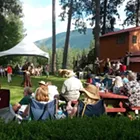This Friday, says Preu, "We're doing two big, substantial concertos -- you don't usually get to do that, get that involved" in a short time with the music of a single composer, he says.
With its massive, tragic opening, the First Piano Concerto will present a challenge for soloist Arnaldo Cohen. "Brahms' pianistic writing is very orchestral," says Preu, noting that this particular concerto began life as a sonata for two pianos. "When you have piano, for two even, you have very thick textures," says Preu. But there comes a point when it becomes "just too big for piano." And sure enough, Brahms tried turning his dual piano sonata into a symphony before he finally settled on creating what turned out merely to be one of the most monumental piano concertos ever composed.
"You can compare the slow movement, the Adagio, especially to the Fourth Piano Concerto of Beethoven. There's a tragic dialogue there between orchestra and soloist that sounds like Beethoven." In fact, as if to emphasize this burden of the past, Brahms stood at his desk and composed with a bust of Beethoven overlooking his work space.
& lt;span class= "dropcap " & F & lt;/span & riday's concert will open with the Langsamer Satz ("Slow Movement"), a 13-minute piece for string choir, based on an idyllic day in the Austrian Alps that the 21-year-old Anton Webern spent hiking with his eventual wife. Yet even though he lived another 40 years, Webern never heard it performed. Its first performance, in fact, wasn't until 1962 in Seattle -- all because the world's preeminent Webern scholar, Hans Moldenhauer, had stopped in Spokane on the train and decided to stay in Washington state. "He was a mountain guy," says Preu. "Practically the first thing he did was to go up Mount Rainier."
So the reason that the Spokane Symphony has access today to the Moldenhauer Archives (which includes the Langsamer Satz, and much of which is housed at Whitworth and WSU) is because some 70 years ago, a German gentleman took a hankering to all our mountains and trees.
But why include the Webern in an otherwise all-Brahms celebration? "Well, it fits and it doesn't fit," says Preu. "First of all, they are both Viennese. But a major reason is the Moldenhauer Archive -- it puts the music history in context. Brahms dies in 1897, and this is just a few years later, but there is a huge difference. After hearing the Webern, Brahms sounds less romantic."
& lt;span class= "dropcap " & A & lt;/span & s for the concerto in the first half of Friday night's concert: It's so technically daunting that the 19th-century German conductor Hans von Bulow termed it not so much a concerto for the violin as "against the violin." The finale is a slashing Gypsy rondo with a blazing finish; the middle movement is a love song to Clara Schumann, Brahms' beloved mentor.
Brahms worked hard in his Violin Concerto to meld the contributions of orchestra and soloist. The oboe plays such a prominent part in the Adagio, in fact, that the work becomes, temporarily, almost a double concerto. In fact, the 19th-century Spanish violin virtuoso, Pablo de Sarasate, declared that he didn't want to play Brahms' concerto because he didn't want to "stand around while the oboe played the only melody in the piece."
But Preu says that coordinating the sounds of the oboe and violin -- to be played, respectively, by the Symphony's principal oboe, Keith Thomas, and by soloist Jennifer Frautschi -- isn't his biggest concern when it comes to the Violin Concerto's second movement: "The oboe plays by herself" -- he explains that "oboe" is a feminine noun in German -- "and the violinist takes that and elaborates the melody. But what will take time" in rehearsal, says Preu, is that "both concertos have a very exposed, very complicated section for woodwinds and horns -- very transparent, and highly complicated in terms of intonation.
"There is something transcendent in Brahms," says Preu. "And there is nothing more beautiful than the end of the second movement of the Violin Concerto."
All this talk of Brahmsian beauty and perfectionism can only go so far, however. Because when it came to matters of personal grooming, apparently Brahms himself wasn't perfectionistic enough. The story goes that, in hurrying to the concert hall to conduct his Violin Concerto's premiere on New Year's Day in 1879, the great man forgot to fasten his suspenders. During the concert, his trousers sagged lower and lower. Fortunately for Brahms, as Yehudi Menuhin notes, "the concerto ended before the expected sartorial denouement."
Note to Eckart: We're glad that you've been enjoying your own personal, month-long Brahms blast. But on Friday night, don't forget to buckle up.
Eckart Preu conducts the Spokane Symphony in the "Brahms Blast" on Friday, Oct. 6, at 8 pm at the INB Center, 334 W. Spokane Falls Blvd. Tickets: $15-$35. Visit spokanesymphony.org or call 624-1200.















